昨日内容回顾

1. 为什么要做前后端分离? - 前后端交给不同的人来编写,职责划分明确。 - API (IOS,安卓,PC,微信小程序...) - vue.js等框架编写前端时,会比之前写jQuery更简单快捷。 2. 对于后端人员,主要为前端提供:API(接口) 以前的你的接口: http://127.0.0.1:8000/index/ http://127.0.0.1:8000/users/ http://127.0.0.1:8000/add_users/ http://127.0.0.1:8000/del_users/ http://127.0.0.1:8000/edit_users/ restful 规范: http://127.0.0.1:8000/users/ 3. 谈谈你对restful规范的理解? 1. 使用https代替http https://www.luffycity.com/course/detail/web/3 http://www.luffycity.com/course/detail/web/3 2. 在URL中体现自己写的是API https://www.luffycity.com/api/ https://api.luffycity.com/ 可能会跨域 3. 在URL中体现版本 https://www.luffycity.com/api/v1/users https://www.luffycity.com/api/v2/users 4. 名词(面向资源编程) https://www.luffycity.com/api/v1/users https://www.luffycity.com/api/v1/song 5. 行为 https://www.luffycity.com/api/v1/users method: get,获取 post,新建 put,更新 patch,局部更新 delete,删除 6. 条件 https://www.luffycity.com/api/v1/users?page=1 https://www.luffycity.com/api/v1/users?page=1&gender=2 7. 状态码 200 301 302 404 500 推荐使用code: def xx(request): ret = {'code':1000,'data':None} try: ... except Exptions as e: ret['status'] = 1001 ret['error'] = 'xxxx错误' return JsonResponse(ret) 8. 错误信息 { code:10001, error:'用户名或密码错误' } 9. 返回结果: GET: https://www.luffycity.com/api/v1/users 响应: { code: 1000, data: [ {'name':'赵森','age':19}, {'name':'赵云','age':16}, {'name':'赵云','age':16}, {'name':'赵云','age':16}, {'name':'赵云','age':16}, ] } GET: https://www.luffycity.com/api/v1/users/1/ 响应: { code:1000, data:{'name':'赵森','age':19}, } POST: https://www.luffycity.com/api/v1/users 请求体: {'name':'大表哥','age':19} 响应(不要): { code:1000, data:{'id':9, 'name':'大表哥','age':19} } PUT/PATCH: https://www.luffycity.com/api/v1/users 请求体: {'name':'大表哥','age':19} 响应(不要): { code:1000, data:{'id':9, 'name':'大表哥','age':19} } DELETE: ... 10. hyper link 访问:https://www.luffycity.com/api/v1/users { code:1000, data:[ {'id':1,'name':'赵森','age':19, 'depart':https://www.luffycity.com/api/v1/depart/1/}, {'id':1,'name':'赵森','age':19, 'depart':https://www.luffycity.com/api/v1/depart/1/}, {'id':1,'name':'赵森','age':19, 'depart':https://www.luffycity.com/api/v1/depart/1/}, {'id':1,'name':'赵森','age':19, 'depart':https://www.luffycity.com/api/v1/depart/1/}, {'id':1,'name':'赵森','age':19, 'depart':https://www.luffycity.com/api/v1/depart/1/}, ] } https://www.luffycity.com/api/v1/users { code:1000, data:[ {'id':1,'name':'赵森','age':19, 'depart_title':'公关部'}, {'id':1,'name':'赵森','age':19, 'depart_title':'公关部'}, {'id':1,'name':'赵森','age':19, 'depart_title':'公关部'}, {'id':1,'name':'赵森','age':19, 'depart_title':'公关部'}, {'id':1,'name':'赵森','age':19, 'depart_title':'公关部'}, ] } 4. django rest framework框架的作用? 帮助开发者可以快速开发出遵循restful规范的API 5. django rest framework框架都有哪些组件(10)? 版本 权限 认证 节流 分页 解析器 **** 序列化 ***** 视图 **** 路由 渲染器
补充:
http传输的数据是明文的,https传输的数据是加密的
简单情况下,使用status,1表示成功,0表示失败
复杂情况下,使用code,查看支付宝api的code说明
https://docs.open.alipay.com/common/105806
一般写接口的时候,推荐使用code。错误信息是服务器返回的!
根据restful规范,POST请求,要返回新增的完整数据。但是,如果前端不需要这些信息,可以不返回!
规定是死的,人是活的。所以要看应用场景!
delete默认是没有返回信息的,但是,还是得返回一个状态。谁知道你,删除有没有成功呢?
hyper link,返回信息中包含超链接。这个也是看需求了
restful规范,不光是python才有。其他语言,也遵循这个规范!
一、路飞学城背景
初期
2012年,有2个人讲python。其中一个是alex,主要是周末班。有7个人,当时没有固定场所,在7个人所在公司的办公室讲课。
一周换一家公司。
2014年,alex进入汽车之家。2014下半年,和佩奇。讲Python,也是讲周末班。有了固定场所--沙河。
线下班,复制难。不好拿投资,规模扩大难。
第一版:给视频+拉群
第一版,在线教育。弄一个QQ群,将视频放到网上。给钱买视频,比如1000块,拉群进去讨论。
学成率比较低,学员自己坚持不下去。10%以下的成功率!
第二版:51cto合作
第二版,和51cto合作,将视频交由51cto管理。每周三,周五做直播,直播2小时。主要做在线答疑!
前期看直播的人,比较多。做了3次直播之后,指数急剧下滑,因为学员技术参差不齐,后面都听不懂了!
最终以失败告终,51cto下架
第三版:51cto合作-->微职位
由alex和51cto谈判,推动51cto的微职位,就是一对一辅导。现今,51cto官网,还保留者微职位。
还是给视频,并且分配一个导师,协助学员学习。并不是真正的一对一,找兼容人员。比如优秀的毕业生,1000~1500的费用。
导师主动跟进学员学习!
好的导师,一个人,可以对接50个人。有些人,遇到问题,会先自己搞定,搞不定,才会找导师。提升自己的解决问题能力,导师就会很轻松。
学成率也不高,相对于以前的看视频,学成率有提升!
第一个问题,导师问题。导师每周跟进一次。有些不问问题的学生,可能忽略跟进了
第二个问题,学生问题。周末在家一天,大多数学不学下的,出去玩,或者打游戏了。学生不积极,没有明确目标
第三个问题,视频问题。针对的学员的状态,是不同的!还有一些,不录制的视频。跟线上不一样!
第四个问题,扩张问题。光靠线下,无法壮大。
第四版:路飞学城
老男孩,自己做路飞学城。初期,由学生投资,占2%,还有销售投资,2个人,一人50万。路飞学城正式成立!
视频,单独录制
由导致单独录制,根据知识点,录制一小段
导师奖惩
以前是靠人工,现在是自动化。
聊天信息,导师上传到服务器。每周都要有,7天聊天没有,就扣钱!
学员购买课程后,安排导师,导师账号有一定的金额。导师没有安装规定,就扣钱。导师自己肯定不愿意扣钱的,所以会主动跟进!
学员不做作业,导师差评,都扣钱
学员换导师,导师分配的金额就没有了,给另外的导师!
以前导师是兼值的,没有办法做到实时回复,导师也有自己公司的事情要做。
后来招了全职导师,做了服务升级。这些是需要掏钱的!
颠覆了在线教育,以前都是看视频,现在是一对一辅导!
学员奖惩
学生,有奖学金
作业做的好,学的快,有奖励金额!
全线课程6个月,是有时效的。过了6个月,就没有了!需要重新购买,这样可以督促学生学习!
学习是根据阶段的,一个阶段必须考核通过,才能进入下一阶段。不能超阶段学习!
每个模块的视频是按照阶段进行的,不是随意看的!
项目架构
主站
使用vue.js + django rest framework的架构,前后端分离。全面采用https,前端和后端在同一台服务器(同域名同端口),避免跨域问题。
主站,注意是给学员使用的,用来购买课程,查看视频等....
里面没有退款按钮,但是有签订协议的。可以休学,延长时间。
退款,需要联系销售人员确认,跟进。为什么不能做到退款瞬时完成呢?因为有竞争对手,它会刷量。
账户的流入流出,是有手续费的。量大的话,会亏损的。
淘宝目前是7天退款,也是为了避免刷量。
导师后台
主要给导师使用的,账户金额,学员跟进...
管理后台
主要是运营使用,用来上传视频,编辑课程相关信息...
开发人员

主站: - 前端: - 前端姑娘 v1,vue.js 1.0 - 前端姑娘 v2,vue.js 2.0(目前全面使用2.0) - 后端: - 老村长 - 产品经理 - alex/wu sir/文周 导师: 1人 管理后台:1人 + 兼职导师
二、django ContentType组件
请求头ContentType
ContentType指的是请求体的编码类型,常见的类型共有3种:
1. application/x-www-form-urlencoded
这应该是最常见的 POST 提交数据的方式了。浏览器的原生 <form> 表单,如果不设置 enctype 属性,那么最终就会以 application/x-www-form-urlencoded 方式提交数据。请求类似于下面这样(无关的请求头在本文中都省略掉了)

POST http://www.example.com HTTP/1.1 Content-Type: application/x-www-form-urlencoded;charset=utf-8 user=yuan&age=22
2. multipart/form-data
这又是一个常见的 POST 数据提交的方式。我们使用表单上传文件时,必须让 <form> 表单的 enctype 等于 multipart/form-data。直接来看一个请求示例:

POST http://www.example.com HTTP/1.1 Content-Type:multipart/form-data; boundary=----WebKitFormBoundaryrGKCBY7qhFd3TrwA ------WebKitFormBoundaryrGKCBY7qhFd3TrwA Content-Disposition: form-data; name="user" yuan ------WebKitFormBoundaryrGKCBY7qhFd3TrwA Content-Disposition: form-data; name="file"; filename="chrome.png" Content-Type: image/png PNG ... content of chrome.png ... ------WebKitFormBoundaryrGKCBY7qhFd3TrwA--
这个例子稍微复杂点。首先生成了一个 boundary 用于分割不同的字段,为了避免与正文内容重复,boundary 很长很复杂。然后 Content-Type 里指明了数据是以 multipart/form-data 来编码,本次请求的 boundary 是什么内容。消息主体里按照字段个数又分为多个结构类似的部分,每部分都是以 --boundary 开始,紧接着是内容描述信息,然后是回车,最后是字段具体内容(文本或二进制)。如果传输的是文件,还要包含文件名和文件类型信息。消息主体最后以 --boundary-- 标示结束。关于 multipart/form-data 的详细定义,请前往 rfc1867 查看。
这种方式一般用来上传文件,各大服务端语言对它也有着良好的支持。
上面提到的这两种 POST 数据的方式,都是浏览器原生支持的,而且现阶段标准中原生 <form> 表单也只支持这两种方式(通过 <form> 元素的 enctype 属性指定,默认为 application/x-www-form-urlencoded。其实 enctype 还支持 text/plain,不过用得非常少)。
随着越来越多的 Web 站点,尤其是 WebApp,全部使用 Ajax 进行数据交互之后,我们完全可以定义新的数据提交方式,给开发带来更多便利。
3. application/json
application/json 这个 Content-Type 作为响应头大家肯定不陌生。实际上,现在越来越多的人把它作为请求头,用来告诉服务端消息主体是序列化后的 JSON 字符串。由于 JSON 规范的流行,除了低版本 IE 之外的各大浏览器都原生支持 JSON.stringify,服务端语言也都有处理 JSON 的函数,使用 JSON 不会遇上什么麻烦。
JSON 格式支持比键值对复杂得多的结构化数据,这一点也很有用。记得我几年前做一个项目时,需要提交的数据层次非常深,我就是把数据 JSON 序列化之后来提交的。不过当时我是把 JSON 字符串作为 val,仍然放在键值对里,以 x-www-form-urlencoded 方式提交。
举例:
新建一个项目untitled1
修改urls.py

from django.contrib import admin from django.urls import path from app01 import views urlpatterns = [ path('admin/', admin.site.urls), path('index/', views.index), ]
修改views.py

from django.shortcuts import render,HttpResponse from django.views.decorators.csrf import csrf_exempt,csrf_protect # Create your views here. @csrf_exempt # 跳过csrf def index(request): print(request.POST) return HttpResponse('...')
启动项目,访问首页

这个时候,boss,发了一个post请求,给index
新建一个boss.py,放在项目根目录中

import requests requests.post( url='http://127.0.0.1:8000/index/', data={"user":"root","pwd":123} )
执行boss.py,查看Pycharm控制台输出:
<QueryDict: {'pwd': ['123'], 'user': ['root']}>
收到了一条post请求
假设boss发送的是json数据呢?
再次执行boss.py,查看控制台
<QueryDict: {}>
发现得到是空字典?为什么呢?boss说,已经给你发过去了,你怎么回答?
注意:request.POST不是万能的,因为它只接收请求头为application/x-www-form-urlencoded,其他类型一概不支持。
查看源码,只有为application/x-www-form-urlencoded,才会解析数据

def _load_post_and_files(self): """Populate self._post and self._files if the content-type is a form type""" if self.method != 'POST': self._post, self._files = QueryDict(encoding=self._encoding), MultiValueDict() return if self._read_started and not hasattr(self, '_body'): self._mark_post_parse_error() return if self.content_type == 'multipart/form-data': if hasattr(self, '_body'): # Use already read data data = BytesIO(self._body) else: data = self try: self._post, self._files = self.parse_file_upload(self.META, data) except MultiPartParserError: # An error occurred while parsing POST data. Since when # formatting the error the request handler might access # self.POST, set self._post and self._file to prevent # attempts to parse POST data again. # Mark that an error occurred. This allows self.__repr__ to # be explicit about it instead of simply representing an # empty POST self._mark_post_parse_error() raise elif self.content_type == 'application/x-www-form-urlencoded': self._post, self._files = QueryDict(self.body, encoding=self._encoding), MultiValueDict() else: self._post, self._files = QueryDict(encoding=self._encoding), MultiValueDict()
使用request.body,它是万能。它直接接收请求体的原始数据,是一个bytes类型的数据
修改views.py,改为body

from django.shortcuts import render,HttpResponse from django.views.decorators.csrf import csrf_exempt,csrf_protect # Create your views here. @csrf_exempt # 跳过csrf def index(request): print(request.body) return HttpResponse('...')
再次执行脚本,查看控制台输出:
b'{"pwd": 123, "user": "root"}'
如果需要获取user,需要对数据进行解码

from django.shortcuts import render,HttpResponse from django.views.decorators.csrf import csrf_exempt,csrf_protect import json # Create your views here. @csrf_exempt # 跳过csrf def index(request): print(request.body) data = (request.body).decode('utf-8') # 解码 dict_data = json.loads(data) # 反序列化 print(dict_data,type(dict_data)) # 查看类型为dict print(dict_data.get("user")) # 获取user return HttpResponse('...')
再次执行脚本,查看控制台输出:
b'{"user": "root", "pwd": 123}' {'pwd': 123, 'user': 'root'} <class 'dict'> root
ContentType组件
contenttypes 是Django内置的一个应用,可以追踪项目中所有app和model的对应关系,并记录在ContentType表中。
ContentTypes做了什么?
当使用django-admin初始化一个django项目的时候,可以看到在默认的INSTALL_APPS已经包含了django.contrib.contenttypes:
INSTALLED_APPS = [ 'django.contrib.admin', 'django.contrib.auth', 'django.contrib.contenttypes', 'django.contrib.sessions', 'django.contrib.messages', 'django.contrib.staticfiles', ]
而且注意django.contrib.contenttypes是在django.contrib.auth之后,这是因为auth中的permission系统是根据contenttypes来实现的。
接着查阅了一下django.contrib.contenttypes.models文件:

class ContentType(models.Model): app_label = models.CharField(max_length=100) model = models.CharField(_('python model class name'), max_length=100) objects = ContentTypeManager() class Meta: verbose_name = _('content type') verbose_name_plural = _('content types') db_table = 'django_content_type' unique_together = (('app_label', 'model'),) def __str__(self): return self.name
可以看到ContentType就是一个简单的django model,而且它在数据库中的表的名字为django_content_type。
在第一次对Django的model进行migrate之后,就可以发现在数据库中出现了一张默认生成的名为django_content_type的表。
如果没有建立任何的model,默认django_content_type是这样的:

+----+--------------+--------------+ | id | app_label | model | +----+--------------+--------------+ | 1 | admin | logentry | | 2 | auth | group | | 3 | auth | user | | 4 | auth | permission | | 5 | contenttypes | contenttype | | 6 | sessions | session | +----+--------------+--------------+
因此,django_content_type记录了当前的Django项目中所有model所属的app(即app_label属性)以及model的名字(即model属性)。
当然,django_content_type并不只是记录属性这么简单,contenttypes是对model的一次封装,因此可以通过contenttypes动态的访问model类型,而不需要每次import具体的model类型
每当我们创建了新的model并执行数据库迁移后,ContentType表中就会自动新增一条记录。比如我在应用app01的models.py中创建表class Electrics(models.Model): pass。从数据库查看ContentType表,显示如下:
| id | app_label | model |
|---|---|---|
| … | admin, auth等内置应用… | … |
| 5 | contenttypes | contenttype |
| 6 | app01 | electrics |
举例说明
方式1:适用于1张表和另一张表要关联的时候。
那么这个表有什么作用呢?这里提供一个场景,路飞学城
1.路飞学城表设计
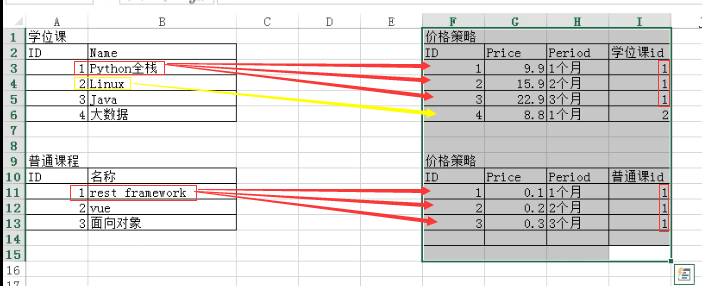
2.将2个价格策略表合并1张表。

3.如果再加一张表,那价格策略表的表结构会发生改变。 这样不合理的,我们的表结构一般设计完就不会改变。
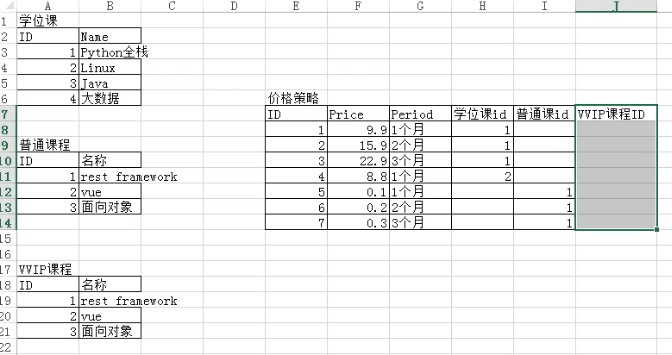
方式2:适用于1张表和多张表关联的时候。
4.接下来换一种方式。表名+id 数据库表结构不会改变。
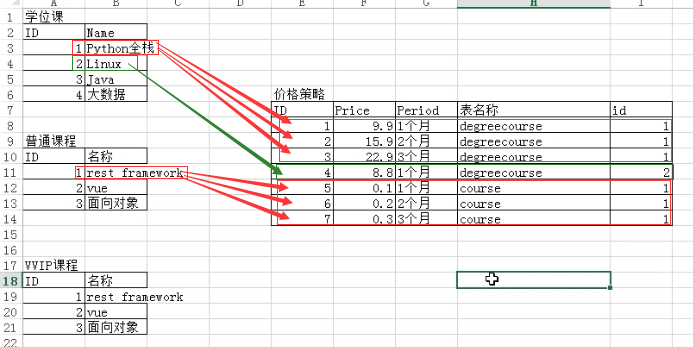
5.创建一个新项目
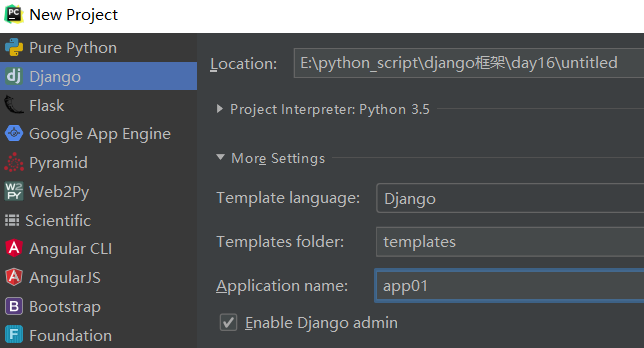
6.创建表
修改models.py

from django.db import models # Create your models here. class Course(models.Model): """ 普通课程 """ title = models.CharField(max_length=32) class DegreeCourse(models.Model): """ 学位课程 """ title = models.CharField(max_length=32) class PricePolicy(models.Model): """ 价格策略 """ price = models.IntegerField() period = models.IntegerField() table_name = models.CharField(verbose_name="关联的表名称") object_id = models.CharField(verbose_name="关联的表中的数据行ID")
方式3:ContentType组件
7.settings.py,默认就有contenttypes
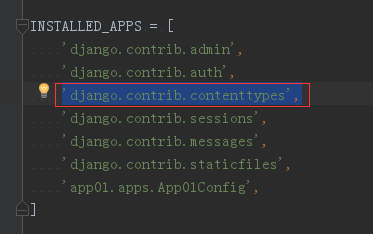
8. 使用ContentType组件
修改models.py
主要改动部分如下:

from django.contrib.contenttypes.fields import GenericForeignKey,GenericRelation from django.contrib.contenttypes.models import ContentType content_type = models.ForeignKey(ContentType, verbose_name="关联的表名称",on_delete=models.CASCADE) object_id = models.IntegerField(verbose_name="关联的表中的数据行ID")
完整代码如下:

from django.db import models from django.contrib.contenttypes.fields import GenericForeignKey,GenericRelation from django.contrib.contenttypes.models import ContentType # Create your models here. class Course(models.Model): """ 普通课程 """ title = models.CharField(max_length=32) class DegreeCourse(models.Model): """ 学位课程 """ title = models.CharField(max_length=32) class PricePolicy(models.Model): """ 价格策略 """ price = models.IntegerField() period = models.IntegerField() content_type = models.ForeignKey(ContentType, verbose_name="关联的表名称",on_delete=models.CASCADE) object_id = models.IntegerField(verbose_name="关联的表中的数据行ID")
9.假设,表数据很多,有个关联表的名字改了,需要改所有的数据很麻烦。那就再创建一张表,专门存放表名字。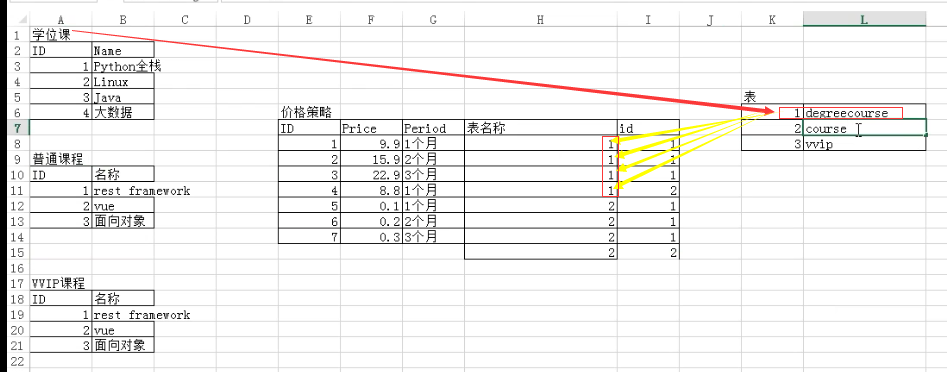
10. 第三张表不用自己创建 ContentType 组件已经帮我们创建好了,专门用来存放表名字。
11.生成表,查看表数据
使用2个命令生成表
python manage.py makemigrations
python manage.py migrate
效果如下:
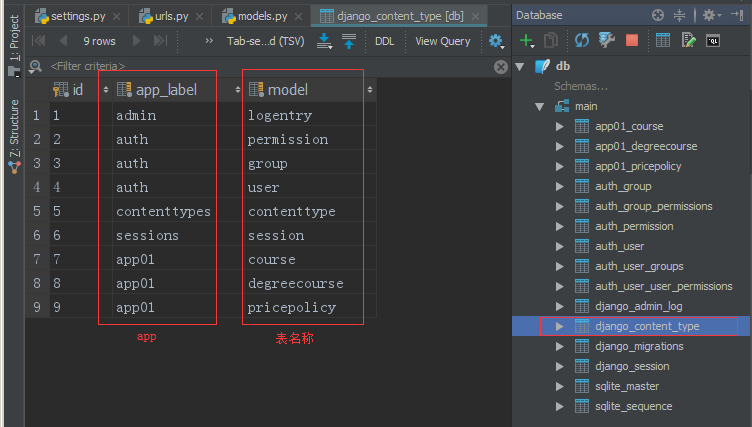
注意:价格策略表,它是万能的。可以适用于任何课程的价格策略。
contenttypes 应用
这里提供一个场景,网上商城购物时,会有各种各样的优惠券,比如通用优惠券,满减券,或者是仅限特定品类的优惠券。在数据库中,可以通过外键将优惠券和不同品类的商品表关联起来:

from django.db import models from django.contrib.contenttypes.fields import GenericForeignKey,GenericRelation from django.contrib.contenttypes.models import ContentType # Create your models here. class Electrics(models.Model): """ id name 1 日立冰箱 2 三星电视 3 小天鹅洗衣机 """ name = models.CharField(max_length=32) class Foods(models.Model): """ id name 1 面包 2 烤鸭 """ name = models.CharField(max_length=32) class Clothes(models.Model): name = models.CharField(max_length=32) class Coupon(models.Model): """ id name Electrics Foods Clothes more... 1 通用优惠券 null null null 2 冰箱满减券 2 null null 3 面包狂欢节 null 1 null """ name = models.CharField(max_length=32) electric_obj = models.ForeignKey(to='Electrics', null=True,on_delete=models.CASCADE) food_obj = models.ForeignKey(to='Foods', null=True,on_delete=models.CASCADE) cloth_obj = models.ForeignKey(to='Clothes', null=True,on_delete=models.CASCADE)
如果是通用优惠券,那么所有的ForeignKey为null,如果仅限某些商品,那么对应商品ForeignKey记录该商品的id,不相关的记录为null。但是这样做是有问题的:实际中商品品类繁多,而且很可能还会持续增加,那么优惠券表中的外键将越来越多,但是每条记录仅使用其中的一个或某几个外键字段。
通过使用contenttypes 应用中提供的特殊字段GenericForeignKey,我们可以很好的解决这个问题。只需要以下三步:
- 在model中定义ForeignKey字段,并关联到ContentType表。通常这个字段命名为“content_type”
- 在model中定义PositiveIntegerField字段,用来存储关联表中的主键。通常这个字段命名为“object_id”
- 在model中定义GenericForeignKey字段,传入上述两个字段的名字。
为了更方便查询商品的优惠券,我们还可以在商品类中通过GenericRelation字段定义反向关系。
创建一个新的项目tmall
修改models.py

from django.db import models from django.contrib.contenttypes.models import ContentType from django.contrib.contenttypes.fields import GenericForeignKey,GenericRelation class Electrics(models.Model): name = models.CharField(max_length=32) coupons = GenericRelation(to='Coupon') # 用于反向查询,不会生成表字段 def __str__(self): return self.name class Foods(models.Model): name = models.CharField(max_length=32) coupons = GenericRelation(to='Coupon') def __str__(self): return self.name class Clothes(models.Model): name = models.CharField(max_length=32) coupons = GenericRelation(to='Coupon') def __str__(self): return self.name class Coupon(models.Model): name = models.CharField(max_length=32) content_type = models.ForeignKey(ContentType,on_delete=models.CASCADE,default=None) # step 1 object_id = models.PositiveIntegerField(default=None) # step 2 content_object = GenericForeignKey('content_type', 'object_id') # step 3 def __str__(self): return self.name class OftenAskedQuestion(models.Model): """常见问题""" content_type = models.ForeignKey(ContentType,on_delete=models.CASCADE,default=None) object_id = models.PositiveIntegerField(default=None) content_object = GenericForeignKey('content_type', 'object_id') question = models.CharField(max_length=255) answer = models.TextField(max_length=1024)
使用2个命令,生成表
python manage.py makemigrations
python manage.py migrate
创建记录和查询
使用navicat打开sqllite数据库,执行以下sq

INSERT INTO app01_coupon ("id", "name", "content_type_id", "object_id") VALUES (1, '通用优惠券', 7, 2); INSERT INTO app01_coupon ("id", "name", "content_type_id", "object_id") VALUES (2, '冰箱满减券', 7, 1); INSERT INTO app01_coupon ("id", "name", "content_type_id", "object_id") VALUES (3, '面包狂欢节', 8, 1); INSERT INTO app01_electrics ("id", "name") VALUES (1, '日立冰箱'); INSERT INTO app01_electrics ("id", "name") VALUES (2, '三星电视'); INSERT INTO app01_electrics ("id", "name") VALUES (3, '小天鹅洗衣机'); INSERT INTO app01_foods ("id", "name") VALUES (1, '面包'); INSERT INTO app01_foods ("id", "name") VALUES (2, '烤鸭'); INSERT INTO app01_oftenaskedquestion ("id", "object_id", "question", "answer", "content_type_id") VALUES (1, 1, '多少钱', 10, 7);
解释一下,electrics和oftenaskedquestion是如何关联的
先来看django_content_type表记录,electrics表对应的主键id为7
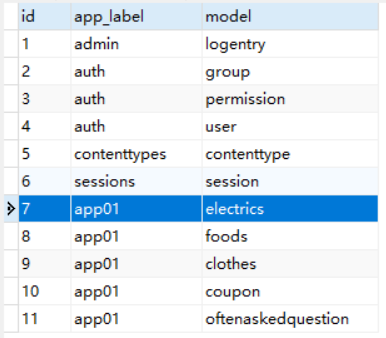
再看看oftenaskedquestion表记录

object_id表示electrics表的主键id=1的记录
question,表示问题
answer,表示答案
content_type_id,表示electrics表在django_content_type表中的主键id
通过最后一条sql语句,electrics表和oftenaskedquestion表,就建立了一条关联记录!
修改urls.py

from django.contrib import admin from django.urls import path from app01 import views urlpatterns = [ path('admin/', admin.site.urls), path('test/', views.test), ]
修改views.py

from django.shortcuts import render, HttpResponse from app01 import models from django.contrib.contenttypes.models import ContentType def test(request): if request.method == 'GET': # ContentType表对象有model_class() 方法,取到对应model content = ContentType.objects.filter(app_label='app01', model='electrics').first() # 表名小写 cloth_class = content.model_class() # cloth_class 就相当于models.Electrics res = cloth_class.objects.all() print(res) # 为三星电视(id=2)创建一条优惠记录 s_tv = models.Electrics.objects.filter(id=2).first() print(s_tv) # models.Coupon.objects.create(name='电视优惠券', content_object=s_tv) # 查询优惠券(id=1)绑定了哪些商品 coupon_obj = models.Coupon.objects.filter(id=1).first() prod = coupon_obj.content_object print(prod) # # 查询三星电视(id=2)的所有优惠券 res = s_tv.coupons.all() print(res) # # 查询obj的所有优惠券:如果没有定义反向查询字段,通过如下方式: content = ContentType.objects.filter(app_label='app01', model='electrics').first() print(content) res = models.OftenAskedQuestion.objects.filter(content_type=content, object_id=coupon_obj.pk).all() print(res) return HttpResponse('....')
启动项目,访问页面

查看Pycharm控制台输出:
<QuerySet [<Electrics: 日立冰箱>, <Electrics: 三星电视>, <Electrics: 小天鹅洗衣机>]> 三星电视 三星电视 <QuerySet [<Coupon: 通用优惠券>]> electrics <QuerySet [<OftenAskedQuestion: OftenAskedQuestion object (1)>]>
总结:
当一张表和多个表FK关联,并且多个FK中只能选择其中一个或其中n个时,可以利用contenttypes app,只需定义三个字段就搞定!
一、路飞学城表结构
创建项目luffycity,应用名为api。注意:django版本为1.11
修改models.py

from django.contrib.contenttypes.fields import GenericForeignKey, GenericRelation from django.contrib.contenttypes.models import ContentType from django.db.models import Q from django.utils.safestring import mark_safe from django.db import models import hashlib # ######################## 课程相关 ######################## class CourseCategory(models.Model): """课程大类, e.g 前端 后端...""" name = models.CharField(max_length=64, unique=True) def __str__(self): return "%s" % self.name class Meta: verbose_name_plural = "01.课程大类" class CourseSubCategory(models.Model): """课程子类, e.g python linux """ category = models.ForeignKey("CourseCategory") name = models.CharField(max_length=64, unique=True) def __str__(self): return "%s" % self.name class Meta: verbose_name_plural = "02.课程子类" class DegreeCourse(models.Model): """学位课程""" name = models.CharField(max_length=128, unique=True) course_img = models.CharField(max_length=255, verbose_name="缩略图") brief = models.TextField(verbose_name="学位课程简介", ) total_scholarship = models.PositiveIntegerField(verbose_name="总奖学金(贝里)", default=40000) # 2000 2000 mentor_compensation_bonus = models.PositiveIntegerField(verbose_name="本课程的导师辅导费用(贝里)", default=15000) period = models.PositiveIntegerField(verbose_name="建议学习周期(days)", default=150) # 为了计算学位奖学金 prerequisite = models.TextField(verbose_name="课程先修要求", max_length=1024) teachers = models.ManyToManyField("Teacher", verbose_name="课程讲师") # 用于GenericForeignKey反向查询, 不会生成表字段,切勿删除 # coupon = GenericRelation("Coupon") # 用于GenericForeignKey反向查询,不会生成表字段,切勿删除 degreecourse_price_policy = GenericRelation("PricePolicy") def __str__(self): return self.name class Meta: verbose_name_plural = "03.学位课" class Teacher(models.Model): """讲师、导师表""" name = models.CharField(max_length=32) role_choices = ((0, '讲师'), (1, '导师')) role = models.SmallIntegerField(choices=role_choices, default=0) title = models.CharField(max_length=64, verbose_name="职位、职称") signature = models.CharField(max_length=255, help_text="导师签名", blank=True, null=True) image = models.CharField(max_length=128) brief = models.TextField(max_length=1024) def __str__(self): return self.name class Meta: verbose_name_plural = "04.导师或讲师" class Scholarship(models.Model): """学位课程奖学金""" degree_course = models.ForeignKey("DegreeCourse") time_percent = models.PositiveSmallIntegerField(verbose_name="奖励档位(时间百分比)", help_text="只填百分值,如80,代表80%") value = models.PositiveIntegerField(verbose_name="奖学金数额") def __str__(self): return "%s:%s" % (self.degree_course, self.value) class Meta: verbose_name_plural = "05.学位课奖学金" class Course(models.Model): """专题课/学位课模块表""" name = models.CharField(max_length=128, unique=True) course_img = models.CharField(max_length=255) sub_category = models.ForeignKey("CourseSubCategory") course_type_choices = ((0, '付费'), (1, 'VIP专享'), (2, '学位课程')) course_type = models.SmallIntegerField(choices=course_type_choices) # 不为空;学位课的某个模块 # 为空;专题课 degree_course = models.ForeignKey("DegreeCourse", blank=True, null=True, help_text="若是学位课程,此处关联学位表") brief = models.TextField(verbose_name="课程概述", max_length=2048) level_choices = ((0, '初级'), (1, '中级'), (2, '高级')) level = models.SmallIntegerField(choices=level_choices, default=1) pub_date = models.DateField(verbose_name="发布日期", blank=True, null=True) period = models.PositiveIntegerField(verbose_name="建议学习周期(days)", default=7) # order = models.IntegerField("课程顺序", help_text="从上一个课程数字往后排") attachment_path = models.CharField(max_length=128, verbose_name="课件路径", blank=True, null=True) status_choices = ((0, '上线'), (1, '下线'), (2, '预上线')) status = models.SmallIntegerField(choices=status_choices, default=0) template_id = models.SmallIntegerField("前端模板id", default=1) # coupon = GenericRelation("Coupon") # 用于GenericForeignKey反向查询,不会生成表字段,切勿删除 price_policy = GenericRelation("PricePolicy") asked_question = GenericRelation("OftenAskedQuestion") def __str__(self): return "%s(%s)" % (self.name, self.get_course_type_display()) def save(self, *args, **kwargs): if self.course_type == 2: if not self.degree_course: raise ValueError("学位课程必须关联对应的学位表") super(Course, self).save(*args, **kwargs) class Meta: verbose_name_plural = "06.专题课或学位课模块" class CourseDetail(models.Model): """课程详情页内容""" course = models.OneToOneField("Course") hours = models.IntegerField("课时") course_slogan = models.CharField(max_length=125, blank=True, null=True) video_brief_link = models.CharField(verbose_name='课程介绍', max_length=255, blank=True, null=True) why_study = models.TextField(verbose_name="为什么学习这门课程") what_to_study_brief = models.TextField(verbose_name="我将学到哪些内容") career_improvement = models.TextField(verbose_name="此项目如何有助于我的职业生涯") prerequisite = models.TextField(verbose_name="课程先修要求", max_length=1024) recommend_courses = models.ManyToManyField("Course", related_name="recommend_by", blank=True) teachers = models.ManyToManyField("Teacher", verbose_name="课程讲师") def __str__(self): return "%s" % self.course class Meta: verbose_name_plural = "07.课程或学位模块详细" class OftenAskedQuestion(models.Model): """常见问题""" content_type = models.ForeignKey(ContentType) # 关联course or degree_course object_id = models.PositiveIntegerField() content_object = GenericForeignKey('content_type', 'object_id') question = models.CharField(max_length=255) answer = models.TextField(max_length=1024) def __str__(self): return "%s-%s" % (self.content_object, self.question) class Meta: unique_together = ('content_type', 'object_id', 'question') verbose_name_plural = "08. 常见问题" class CourseOutline(models.Model): """课程大纲""" course_detail = models.ForeignKey("CourseDetail") title = models.CharField(max_length=128) # 前端显示顺序 order = models.PositiveSmallIntegerField(default=1) content = models.TextField("内容", max_length=2048) def __str__(self): return "%s" % self.title class Meta: unique_together = ('course_detail', 'title') verbose_name_plural = "09. 课程大纲" class CourseChapter(models.Model): """课程章节""" course = models.ForeignKey("Course", related_name='coursechapters') chapter = models.SmallIntegerField(verbose_name="第几章", default=1) name = models.CharField(max_length=128) summary = models.TextField(verbose_name="章节介绍", blank=True, null=True) pub_date = models.DateField(verbose_name="发布日期", auto_now_add=True) class Meta: unique_together = ("course", 'chapter') verbose_name_plural = "10. 课程章节" def __str__(self): return "%s:(第%s章)%s" % (self.course, self.chapter, self.name) class CourseSection(models.Model): """课时目录""" chapter = models.ForeignKey("CourseChapter", related_name='coursesections') name = models.CharField(max_length=128) order = models.PositiveSmallIntegerField(verbose_name="课时排序", help_text="建议每个课时之间空1至2个值,以备后续插入课时") section_type_choices = ((0, '文档'), (1, '练习'), (2, '视频')) section_type = models.SmallIntegerField(default=2, choices=section_type_choices) section_link = models.CharField(max_length=255, blank=True, null=True, help_text="若是video,填vid,若是文档,填link") video_time = models.CharField(verbose_name="视频时长", blank=True, null=True, max_length=32) # 仅在前端展示使用 pub_date = models.DateTimeField(verbose_name="发布时间", auto_now_add=True) free_trail = models.BooleanField("是否可试看", default=False) class Meta: unique_together = ('chapter', 'section_link') verbose_name_plural = "11. 课时" def __str__(self): return "%s-%s" % (self.chapter, self.name) class Homework(models.Model): chapter = models.ForeignKey("CourseChapter") title = models.CharField(max_length=128, verbose_name="作业题目") order = models.PositiveSmallIntegerField("作业顺序", help_text="同一课程的每个作业之前的order值间隔1-2个数") homework_type_choices = ((0, '作业'), (1, '模块通关考核')) homework_type = models.SmallIntegerField(choices=homework_type_choices, default=0) requirement = models.TextField(max_length=1024, verbose_name="作业需求") threshold = models.TextField(max_length=1024, verbose_name="踩分点") recommend_period = models.PositiveSmallIntegerField("推荐完成周期(天)", default=7) scholarship_value = models.PositiveSmallIntegerField("为该作业分配的奖学金(贝里)") note = models.TextField(blank=True, null=True) enabled = models.BooleanField(default=True, help_text="本作业如果后期不需要了,不想让学员看到,可以设置为False") class Meta: unique_together = ("chapter", "title") verbose_name_plural = "12. 章节作业" def __str__(self): return "%s - %s" % (self.chapter, self.title) # class CourseReview(models.Model): # """课程评价""" # enrolled_course = models.OneToOneField("EnrolledCourse") # about_teacher = models.FloatField(default=0, verbose_name="讲师讲解是否清晰") # about_video = models.FloatField(default=0, verbose_name="内容实用") # about_course = models.FloatField(default=0, verbose_name="课程内容通俗易懂") # review = models.TextField(max_length=1024, verbose_name="评价") # disagree_number = models.IntegerField(default=0, verbose_name="踩") # agree_number = models.IntegerField(default=0, verbose_name="赞同数") # tags = models.ManyToManyField("Tags", blank=True, verbose_name="标签") # date = models.DateTimeField(auto_now_add=True, verbose_name="评价日期") # is_recommend = models.BooleanField("热评推荐", default=False) # hide = models.BooleanField("不在前端页面显示此条评价", default=False) # # def __str__(self): # return "%s-%s" % (self.enrolled_course.course, self.review) # # class Meta: # verbose_name_plural = "13. 课程评价(购买课程后才能评价)" # # # class DegreeCourseReview(models.Model): # """学位课程评价 # 为了以后可以定制单独的评价内容,所以不与普通课程的评价混在一起,单独建表 # """ # enrolled_course = models.ForeignKey("EnrolledDegreeCourse") # course = models.ForeignKey("Course", verbose_name="评价学位模块", blank=True, null=True, # help_text="不填写即代表评价整个学位课程", limit_choices_to={'course_type': 2}) # about_teacher = models.FloatField(default=0, verbose_name="讲师讲解是否清晰") # about_video = models.FloatField(default=0, verbose_name="视频质量") # about_course = models.FloatField(default=0, verbose_name="课程") # review = models.TextField(max_length=1024, verbose_name="评价") # disagree_number = models.IntegerField(default=0, verbose_name="踩") # agree_number = models.IntegerField(default=0, verbose_name="赞同数") # tags = models.ManyToManyField("Tags", blank=True, verbose_name="标签") # date = models.DateTimeField(auto_now_add=True, verbose_name="评价日期") # is_recommend = models.BooleanField("热评推荐", default=False) # hide = models.BooleanField("不在前端页面显示此条评价", default=False) # # def __str__(self): # return "%s-%s" % (self.enrolled_course, self.review) # # class Meta: # verbose_name_plural = "14. 学位课评价(购买课程后才能评价)" class PricePolicy(models.Model): """价格与有课程效期表""" content_type = models.ForeignKey(ContentType) # 关联course or degree_course object_id = models.PositiveIntegerField() content_object = GenericForeignKey('content_type', 'object_id') # course = models.ForeignKey("Course") valid_period_choices = ((1, '1天'), (3, '3天'), (7, '1周'), (14, '2周'), (30, '1个月'), (60, '2个月'), (90, '3个月'), (180, '6个月'), (210, '12个月'), (540, '18个月'), (720, '24个月'), ) valid_period = models.SmallIntegerField(choices=valid_period_choices) price = models.FloatField() class Meta: unique_together = ("content_type", 'object_id', "valid_period") verbose_name_plural = "15. 价格策略" def __str__(self): return "%s(%s)%s" % (self.content_object, self.get_valid_period_display(), self.price)
关键字解释:
Course表
Course表里面有price_policy属性,里面定义了GenericRelation,它是用来做反向查询的
表示它会从django_content_type表中找到model字段为pricepolicy(价格策略表)
PricePolicy表
content_type,约定俗成叫这个命令,它和django_content_type表做了外键关联。ContentType表示django_content_type表
object_id 表示关联表中的主键。通常这个字段命名为“object_id”。
content_object 传入上述两个字段的名字,用来建立外键关系。
Course表,假设id=1,课程名为Python全栈。要加一条价格策略,比如7天30块
查看django_content_type表,course的id为8
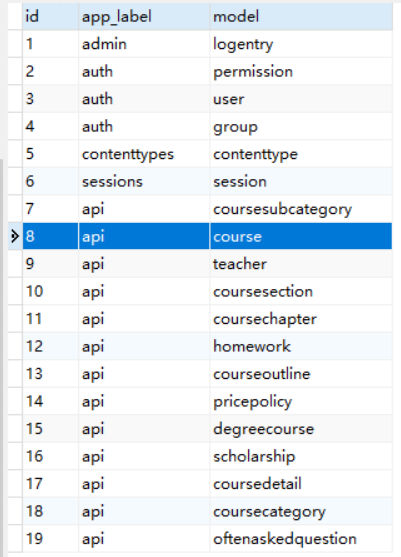
那么api_pricepolicy表的记录应该这么写

object_id,表示关联表的主键id,也就是course表的id=1的记录
vaild_period,表示有效期
price,表示价格
content_type_id,表示django_content_type表中主键id。8就表示course表
通过这样,2个表,就建立了一条关系!
django_content_type对所有表做了外键,所以它记录了所有表名!
假设,需要查询Course表中id=1的课程所有价格策略,可以这么查询
obj = models.Course.objects.filter(id=1).first()print(i.price_policy.all())
all()表示查询所有记录
假设,查询所有课程的价格策略
obj = models.Course.objects.all() for i in obj: print(i.price_policy.all())
显示课程列表,并打印每个课程的所有价格信息
obj = models.Course.objects.all() for i in obj: print(i.name) ps = i.price_policy.all() for p in ps: print('-->',p.valid_period,p.price)
执行之后,效果应该是这样的
Python开发入门7天特训营 --> 7 10.0 --> 30 50.0 Linux系统基础5周入门精讲 --> 14 20.0 --> 60 80.0
Course表里面有专题课和学位课。
专题课,可以单独售卖。
Course里面的degree_course。为空,表示专题课。否则为学位课!
判断为空,使用如下语句
models.Course.objects.filter(degree_course__isnull=True)
表结构图关系图如下:
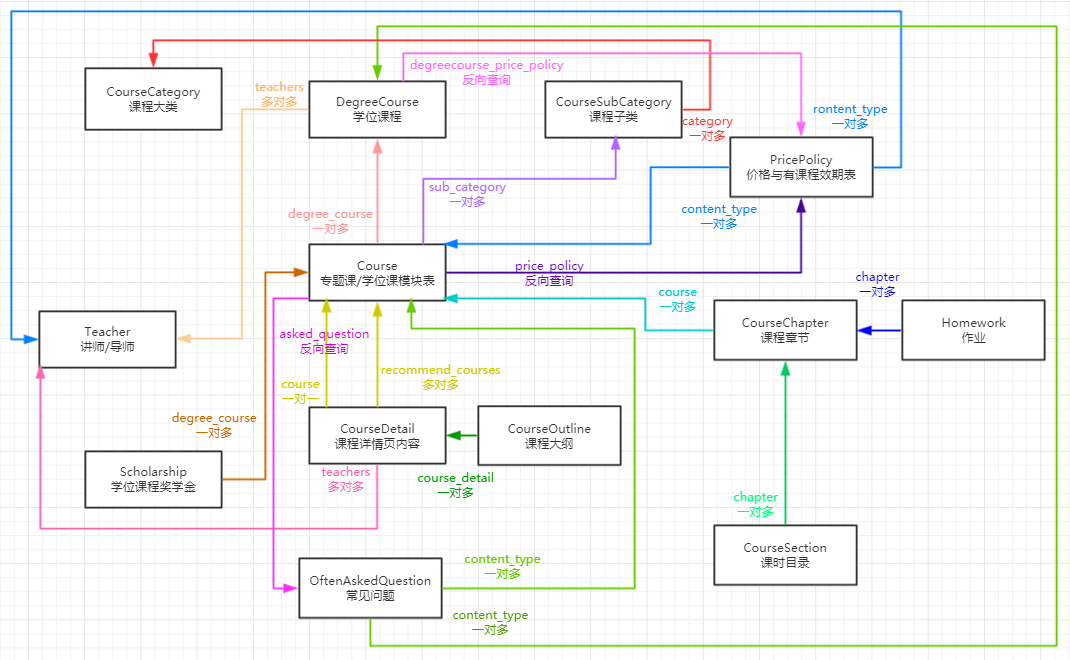
总结:

1. django contenttypes组件的作用? - 数据库迁移时,找到所有app中的表并录入到django_content_type表 - 内置两个字段: GenericRelation GenericForeignKey 2. 使用contenttypes组件 3. 路飞表结构 a. 课程分类 - 课程大类 - 课程子类 b. 学位课 - 学位课 - 奖学金 - 老师 c. 专题课 or 学位课模块 - 专题课 or 学位课模块 - 课程详细 - 课程大纲 - 常见问题 - 章节 - 课时 - 作业 d. 价格 - 价格策略
今日作业:

一、准备工作: 1. 通过admin对13张表录入数据 2. ORM练习 a. 查看所有学位课并打印学位课名称以及授课老师 b. 查看所有学位课并打印学位课名称以及学位课的奖学金 c. 展示所有的专题课 models.Course.objects.filter(degree_course__isnull=True) d. 查看id=1的学位课对应的所有模块名称 e. 获取id=1的专题课,并打印:课程名、级别(中文)、why_study、what_to_study_brief、所有recommend_courses f. 获取id=1的专题课,并打印该课程相关的所有常见问题 g. 获取id=1的专题课,并打印该课程相关的课程大纲 h. 获取id=1的专题课,并打印该课程相关的所有章节 i. 获取id=1的专题课,并打印该课程相关的所有课时 第1章·Python 介绍、基础语法、流程控制 01-课程介绍(一) 01-课程介绍(一) 01-课程介绍(一) 01-课程介绍(一) 01-课程介绍(一) 第1章·Python 介绍、基础语法、流程控制 01-课程介绍(一) 01-课程介绍(一) 01-课程介绍(一) 01-课程介绍(一) 01-课程介绍(一) i. 获取id=1的专题课,并打印该课程相关的所有的价格策略 二、基于django rest framework 写路飞的接口(作业一+rest framework 序列化) - 课程列表API - 课程详细API
答案
一、ORM查询

a. 查看所有学位课并打印学位课名称以及授课老师 obj = models.DegreeCourse.objects.values("name","teachers__name") print(obj) b. 查看所有学位课并打印学位课名称以及学位课的奖学金 obj = models.DegreeCourse.objects.all().values("name","total_scholarship") print(obj) c. 展示所有的专题课 obj = models.Course.objects.filter(degree_course__isnull=True) d. 查看id=1的学位课对应的所有模块名称 obj = models.Course.objects.filter(id=1).values("name","degree_course") e. 获取id=1的专题课,并打印:课程名、级别(中文)、why_study、what_to_study_brief、所有recommend_courses obj = models.Course.objects.filter(degree_course__isnull=True,id=1).values("name","level","coursedetail__why_study", "coursedetail__what_to_study_brief", "coursedetail__recommend_courses") f. 获取id=1的专题课,并打印该课程相关的所有常见问题 obj = models.Course.objects.filter(id=1) for i in obj: print(i.asked_question.all()) g. 获取id=1的专题课,并打印该课程相关的课程大纲 obj = models.CourseDetail.objects.filter(id=1).values("courseoutline__title") print(obj) h. 获取id=1的专题课,并打印该课程相关的所有章节 obj = models.Course.objects.filter(id=1).values("coursechapters__name") print(obj) i. 获取id=1的专题课,并打印该课程相关的所有的价格策略 obj = models.Course.objects.filter(id=1).values("coursechapters__name","coursechapters__coursesections__name") print(obj)
二、api
github下载地址
